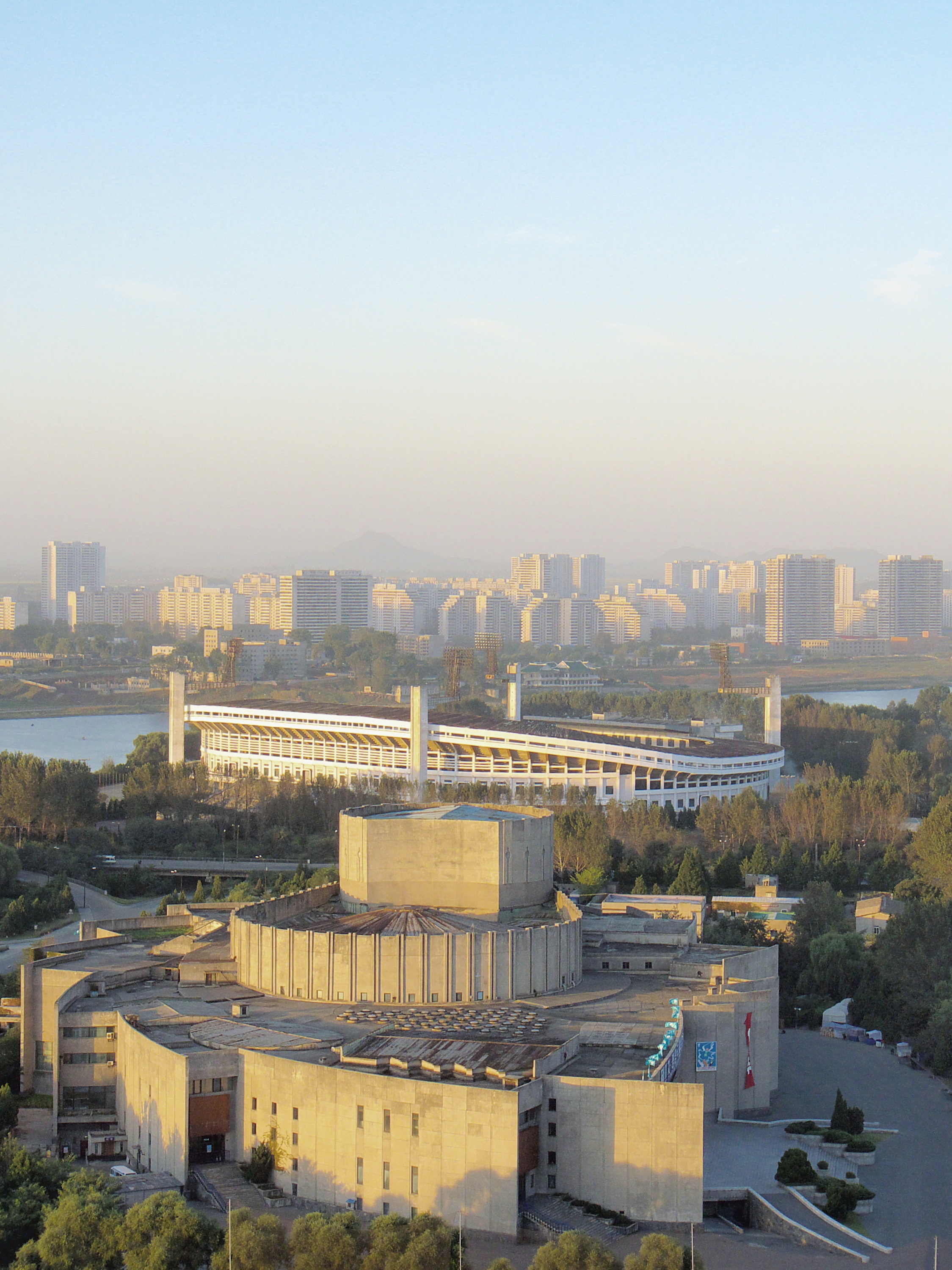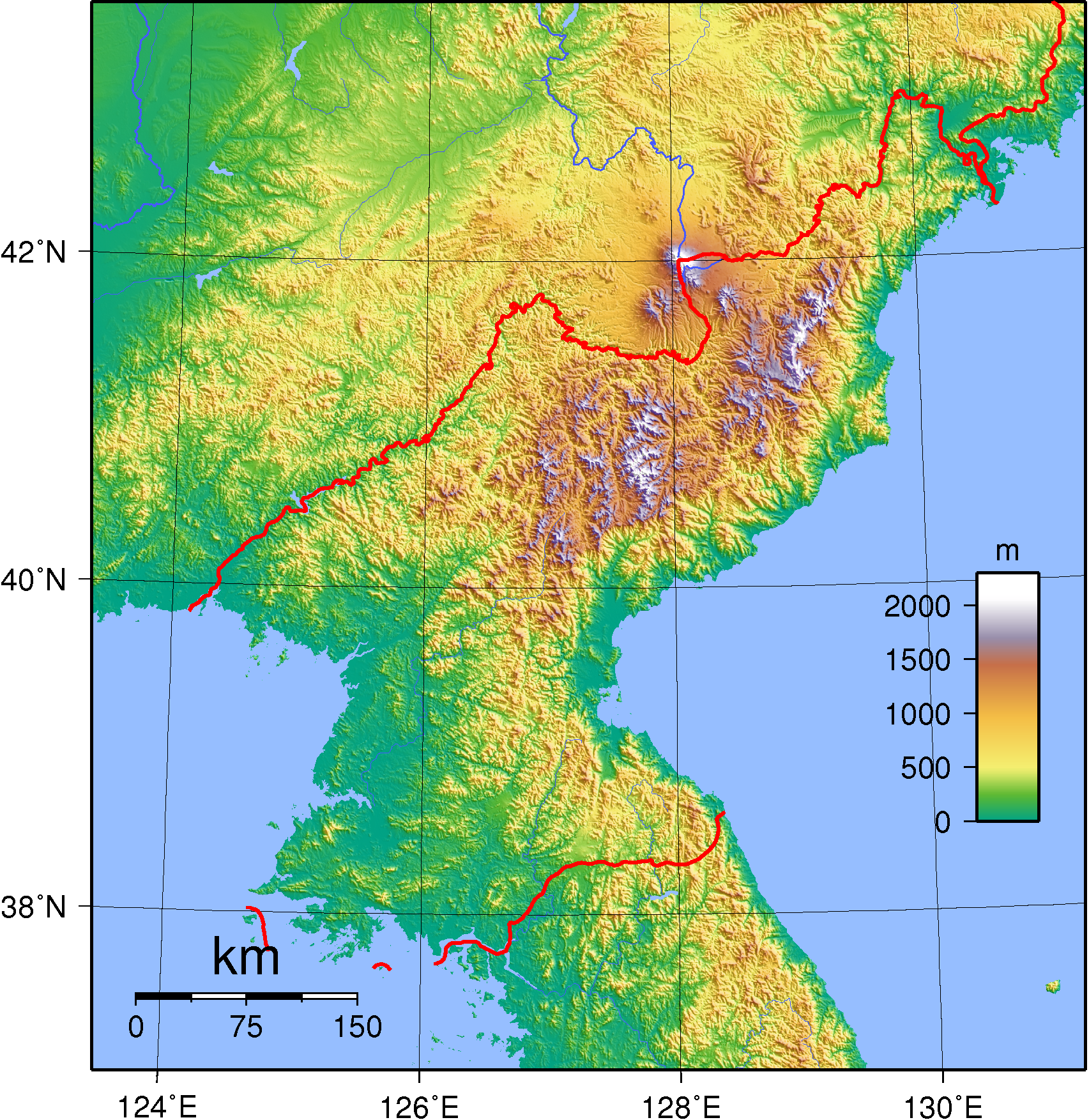|
Yanggak Island
Yanggakdo, or Yanggak Island is a small island in the Taedong River, located about two kilometers to the south-east of the centre of the North Korean capital city Pyongyang. It is connected to the northern and southern side of Pyongyang by the Yanggak Bridge, which spans the island and separates it into a northeastern and southwestern part. The name means "Rams horn island" and is said to be derived from its shape. On its northeastern end the tall Yanggakdo International Hotel is located, the second tallest building in North Korea. Adjacent to the hotel's southern side, there was originally a 9,000 square metre nine-hole golf course which as of 2011 had been demolished to make space for a new Chinese-funded health complex to be built. Also on the northeastern part of Yanggak Island, the Pyongyang International Cinema Hall can be found, which hosts the opening and closing ceremonies of the Pyongyang International Film Festival. The island's southwestern part houses the Yanggakdo S ... [...More Info...] [...Related Items...] OR: [Wikipedia] [Google] [Baidu] |
Taedong River
The Taedong River (Chosŏn'gŭl: ) is a large river in North Korea. The river rises in the Rangrim Mountains of the country's north where it then flows southwest into Korea Bay at Namp'o.Suh, Dae-Sook (1987) "North Korea in 1986: Strengthening the Soviet Connection" ''Asian Survey'' 27(1): pp. 56-63, page 62 In between, it runs through the country's capital, Pyongyang. Along the river are landmarks such as the Juche Tower and Kim Il-sung Square. The river is 439 km or 272.7 mi in length, and is generally deep. It is the fifth-longest river on the Korean peninsula and the second-longest in North Korea. Pyongyang is approximately 110 km upstream from the mouth, Sunchon 192 km upstream, and Taehŭng 414 km upstream. Because of its depth, it is widely used for river transport; it is navigable by large ships up to 65 km inland, although most commercial traffic stops at Songrim. History The kingdom of Koguryo was founded on its shores. Many archeological sites d ... [...More Info...] [...Related Items...] OR: [Wikipedia] [Google] [Baidu] |
North Korea
North Korea, officially the Democratic People's Republic of Korea (DPRK), is a country in East Asia. It constitutes the northern half of the Korea, Korean Peninsula and shares borders with China and Russia to the north, at the Yalu River, Yalu (Amnok) and Tumen River, Tumen rivers, and South Korea to the south at the Korean Demilitarized Zone. North Korea's border with South Korea is a disputed border as both countries claim the entirety of the Korean Peninsula. The country's western border is formed by the Yellow Sea, while its eastern border is defined by the Sea of Japan. North Korea, like South Korea, its southern counterpart, claims to be the legitimate government of the entire peninsula and List of islands of North Korea, adjacent islands. Pyongyang is the capital and largest city. In 1910, Korean Empire, Korea was Korea under Japanese rule, annexed by the Empire of Japan. In 1945, after the Surrender of Japan, Japanese surrender at the End of World War II in Asia, end ... [...More Info...] [...Related Items...] OR: [Wikipedia] [Google] [Baidu] |
Pyongyang
Pyongyang (, , ) is the capital and largest city of North Korea, where it is known as the "Capital of the Revolution". Pyongyang is located on the Taedong River about upstream from its mouth on the Yellow Sea. According to the 2008 population census, it has a population of 3,255,288. Pyongyang is a directly administered city () with equal status to North Korean provinces. Pyongyang is one of the oldest cities in Korea. It was the capital of two ancient Korean kingdoms, Gojoseon and Goguryeo, and served as the secondary capital of Goryeo. Much of the city was destroyed during the First Sino-Japanese War, but it was revived Korea under Japanese rule, under Japanese rule and became an industrial center. Following the establishment of North Korea in 1948, Pyongyang became its ''de facto'' capital. The city was again devastated during the Korean War, but was quickly rebuilt after the war with Soviet Union, Soviet assistance. Pyongyang is the political, industrial and transport ... [...More Info...] [...Related Items...] OR: [Wikipedia] [Google] [Baidu] |
Yanggak Bridge
Yanggak Bridge (양각교) is the second (west–east) of the six major bridges on the Taedong River in Pyongyang. The middle of the bridge has an off-ramp to Yanggak Island Yanggakdo, or Yanggak Island is a small island in the Taedong River, located about two kilometers to the south-east of the centre of the North Korean capital city Pyongyang. It is connected to the northern and southern side of Pyongyang by the Yang ....Justin Corfield ''Historical Dictionary of Pyongyang'' 2014-1783083417 p.17 References Bridges in North Korea Buildings and structures in Pyongyang {{NorthKorea-struct-stub ... [...More Info...] [...Related Items...] OR: [Wikipedia] [Google] [Baidu] |
Yanggakdo International Hotel
The Yanggakdo International Hotel is the largest operating hotel in North Korea, pending the completion of the Ryugyong Hotel, and the country's seventh- or eighth-tallest building. The hotel is located on Yanggak Island in the River Taedong, to the south-east of the centre of Pyongyang, the nation's capital. It rises to an overall height of and has a slowly revolving restaurant on the 47th floor. This hotel is North Korea's first luxury hotel, The structure was built between 1986 and 1992 by France's Campenon Bernard Construction Company and opened in 1996. Background Besides housing the reception, the ground floor offers the purchase of North Korean currency sets, postcards and letters, and basic commodities at Western prices. There is a bar and a bookshop which stocks North Korean reading material including treatises of President Kim Il-sung and General Kim Jong-il. In addition to the revolving restaurant, the hotel guide issued to guests indicates that the hotel contains ... [...More Info...] [...Related Items...] OR: [Wikipedia] [Google] [Baidu] |
Pyongyang International Cinema Hall
The International Cinema Hall () is a cinema located in North Korea. ( ) It holds the . See also *List of theatres in North Korea
This is a list of theaters in North Korea.
* April 25 House of Culture
* Central Youth Hall
* East Pyongyang Grand Theatre
* Hamhung Grand Theatre
* International Cinema Hall
* Kalma Theatre
* Mansudae Art Theatre
* Mansudae Pe ...
[...More Info...] [...Related Items...] OR: [Wikipedia] [Google] [Baidu] |
Pyongyang International Film Festival
The Pyongyang International Film Festival is a biennial cultural exhibition held in Pyongyang, North Korea. Until 2002, the film festival was reserved to "non-aligned and other developing countries". History The event originated in 1987 as the Pyongyang Film Festival of the Non-aligned and Other Developing Countries(쁠럭불가담 및 기타 발전도상 나라들의 평양영화축전). The maiden event, held from September 1 through September 10, showed short films, features, and documentaries that were judged for competitive awards. The film festival returned in 1990 and would be regularly held every other year. Recurrent subject matter included domestic cinema that commonly praised the high leadership such as a film shown at the 1992 film festival, verbosely translated, ''Glory of Our People in Holding the Great Leader in High Esteem'', and foreign films about revolutionary resistance. In 2000, officials widened the acceptable breadth of film watching by screening Japanese f ... [...More Info...] [...Related Items...] OR: [Wikipedia] [Google] [Baidu] |
Yanggakdo Stadium
Yanggakdo Stadium is a multi-purpose stadium located on Yanggak Island in Pyongyang, North Korea. It is currently used mostly for football matches. The stadium holds 30,000 people and was opened on 18 May 1989. In addition to the main football pitch and athletics track, there are indoor training areas for bodybuilding, weightlifting, table tennis, boxing, wrestling, judo, and swimming. There are also dedicated spaces for football referees, changing rooms for players, a broadcasting room, correspondents' and commentator's rooms, and medical facilities. As well as the main pitch, there are three training pitches for football, and eight tennis courts. References See also * List of football stadiums in North Korea This is a list of football stadiums in North Korea. The minimum capacity is 5,000. External links Democratic People's Republic of Korea - Stadiums() World Stadiums - Stadiums in North Korea() References Satellite pictures of North Korean ... {{Stadi ... [...More Info...] [...Related Items...] OR: [Wikipedia] [Google] [Baidu] |
Islands Of North Korea
The following is a list of major islands in North Korea, the Democratic People's Republic of Korea, arranged by province. For a list of islands in South Korea, the Republic of Korea, see: List of islands of South Korea. North Korea occupies the northern portion of the Korean Peninsula which extends about southward from the northeast Asian continental landmass. The coastline of Korea is highly irregular, and North Korea accounts for of this, roughly one-third. To the west of North Korea are the Yellow Sea and Korea Bay, and to its east lies Japan across the Sea of Japan (East Sea of Korea). Most of the islands of North Korea are on its west coast. According to the Constitution of the Republic of Korea, its territory consisting of "the Korean Peninsula and its adjacent islands," which in turn, all of the islands are wholly claimed by the ROK. Kangwon * Hwangt'odo (Hangul: 황토도 Revised Romanization: ''Hwangtodo''; Hanja: 黃土島) (Jurisdiction: Anbyŏn County) * Ku ... [...More Info...] [...Related Items...] OR: [Wikipedia] [Google] [Baidu] |




